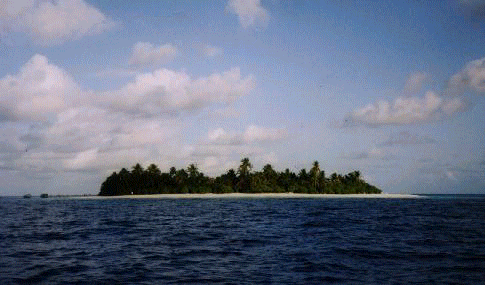Reef Check Report 1998
Angaga Island
Maldives
Dr. rer. nat. Christoph Hauert, Christoph.Hauert@univie.ac.at
Lic. phil. nat. Claudia Hauert-Roden, Claudia.Hauert@freesurf.ch
Dipl. zool. Thomas Stucki, tstucki@zoolmus.unizh.ch

Abstract
Around Angaga island (South Ari Atoll, Maldives) six coral reefs were checked
between June 26th and July 11th 1998 following the Reef Check methods of
the Hong Kong University. The overall condition of all reefs under consideration
was extremely poor: More than 80% of the corals were dead and covered with
a thin layer of algae. Between 5% and 10% of all photosymbiotic hosts were
bleached and only around 5% were still in fair condition. The reason for
this severe condition of the reefs seems to be exceptionally high water
temperatures in February and March of 1998. Hard corals and anemones were
most affected, soft corals least. Of the invertebrate target species according
to the Reef Check methods, only Tridacna gigas and sea cucumbers
were observed regularly. Fish populations appeared to be rather undisturbed,
however a significant lack of larger specimens were observed. Since fishing
and harvesting is prohibited around Angaga island, we suggest that the
reason for this is not due to overfishing but rather a consequence of the
dying reef.
Table of Contents
-
Introduction
-
Angaga
Island
-
Geography
-
Flora
& Fauna
-
Angaga
Resort
-
Reef
Check Sites
-
Housereef
1 (72° 49.402' E, 3° 39.052' N)
-
Housereef
2 (72° 49.364' E, 3° 39.180' N)
-
Housereef
3 (72° 48.999' E, 3° 38.962' N)
-
Pineapple
or Hurashdoo Island (72° 46.737' E, 3° 39.253' N)
-
Namnetti
Tila (72° 52.908' E, 3° 42.274' N)
-
Remas
Faru (72° 47.713' E, 3° 39.720' N)
-
Biological
Data & Results
-
Corals
-
Invertebrates
-
Fish
& Other Vertebrates
-
Public
Relations
-
Suggestions
-
Management
of the Island
-
Reef
Check Organization
-
Acknowledgements

